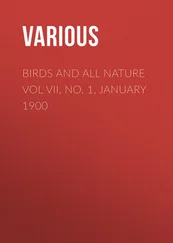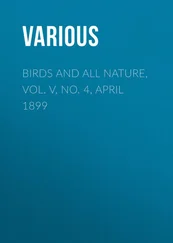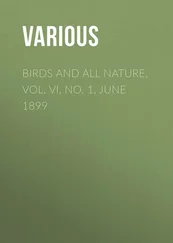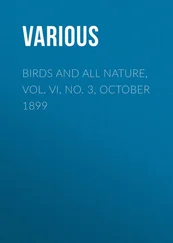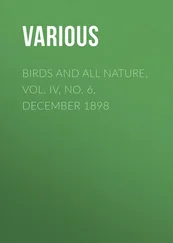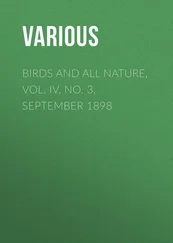Various - Birds and All Nature, Vol. V, No. 3, March 1899
Здесь есть возможность читать онлайн «Various - Birds and All Nature, Vol. V, No. 3, March 1899» — ознакомительный отрывок электронной книги совершенно бесплатно, а после прочтения отрывка купить полную версию. В некоторых случаях можно слушать аудио, скачать через торрент в формате fb2 и присутствует краткое содержание. Жанр: periodic, Биология, Природа и животные, foreign_edu, на английском языке. Описание произведения, (предисловие) а так же отзывы посетителей доступны на портале библиотеки ЛибКат.
- Название:Birds and All Nature, Vol. V, No. 3, March 1899
- Автор:
- Жанр:
- Год:неизвестен
- ISBN:нет данных
- Рейтинг книги:5 / 5. Голосов: 1
-
Избранное:Добавить в избранное
- Отзывы:
-
Ваша оценка:
- 100
- 1
- 2
- 3
- 4
- 5
Birds and All Nature, Vol. V, No. 3, March 1899: краткое содержание, описание и аннотация
Предлагаем к чтению аннотацию, описание, краткое содержание или предисловие (зависит от того, что написал сам автор книги «Birds and All Nature, Vol. V, No. 3, March 1899»). Если вы не нашли необходимую информацию о книге — напишите в комментариях, мы постараемся отыскать её.
Birds and All Nature, Vol. V, No. 3, March 1899 — читать онлайн ознакомительный отрывок
Ниже представлен текст книги, разбитый по страницам. Система сохранения места последней прочитанной страницы, позволяет с удобством читать онлайн бесплатно книгу «Birds and All Nature, Vol. V, No. 3, March 1899», без необходимости каждый раз заново искать на чём Вы остановились. Поставьте закладку, и сможете в любой момент перейти на страницу, на которой закончили чтение.
Интервал:
Закладка:
One day there was a noisy flutter of wings at the door, and the harsh cry of the butcher-bird was heard. On stepping out I saw feathers floating in the air. I concluded that I would see no more of my little companion and helper. The blue-bottle fly was avenged.
THE SQUIRREL'S USE OF HIS TAIL
OF COURSE every one who has had a pet squirrel has noticed what an important thing his tail seems to be to him. When he makes his toilet he usually ends by bringing the hairy brush around and apparently wiping his face with it, as though it were his towel. But I suspect that he is as much concerned, even here, about the care of his tail as about the cleanliness of his features, for Bunny's beauty, like that of some others, lies as much in his train as in his countenance. One use, therefore, of the squirrel's tail is to make him look pretty. I think, at least, no one can see him put it into such graceful curves along with his delightful postures without feeling that he is posing for esthetic effect.
Still, a little study of his ways may make us think that there is a more practical purpose even in this feature of his tail's use. We had a pet squirrel in the house recently – one of the western fox species or variety. He had become quite tame in his cage before he was released in my study. At intervals I had him brought in, and we usually romped together at least once a day.
At first everything was so new and strange to him that he was very shy and must go about investigating. I noticed that, as he approached anything which he feared might prove dangerous, he always projected his tail over his back far forward – sometimes feeling the object with the extreme hairs before touching it with his nose. He annoyed me greatly by tearing the wall paper from a certain angle. One day I threw a pamphlet so as to strike just above his nose while at his mischief. It frightened him badly, and he suspected that the scare had come out of the wall. But he could not resist the fascination of this sport, and it was interesting to watch him approach and try by all sorts of devices of his tail to see if the enemy were within.
If he were walking past or around anything that he feared he kept his tail stretched at full length on the side of his body that was next the object – sometimes he held it many inches from himself. If something moved suddenly in front of him as he ran, his tail shot over him away ahead of his nose, as if projected there by his sudden stop. But it was the natural instinct of thrusting his tail at anything threatening him too suddenly for flight. Much of his play at times was a kind of mock fright in which he seemed to imagine himself pursued by all kinds of enemies – even myself – and the most familiar objects becoming terrible. Then the use he made of his tail was most exaggerated, having in it perhaps some of the elements of terrifying the enemy, as seen in the swelled rails of cats, the bristles of hogs, dogs, etc.
One could not resist the impression that the tail was thrown out as a shield or a screen, but this did not always seem a satisfactory explanation, for it was certainly a very frail thing and very conspicuous. Besides, it would seem to furnish the enemy a good handle to catch hold of.
The theory has been advanced that this last is the very purpose of this use of the tail; and from my study of this pet I became convinced that he thrust out his tail when suddenly surprised in the hope that it might be taken and his body left . The skin on the tail of most rodents (of which the squirrel is one) slips easily from the bone, and leaves, to a grasping enemy, often a little bunch of "hide and hair." So Bunny offers this – feeling that he would rather leave his tail in jeopardy and go into life whole otherwise. The glass-snake (a lizard) in its efforts to escape, frequently breaks off a portion of its tail, which the pursuing enemy may stop to capture while the body wriggles into safety.
This, likewise, is doubtless one of the reasons why the squirrel insists upon the tail's being always curled up over his back while he is absorbed in eating. It is not always merely a beautiful pose. As he thus sits in the trees his greatest enemies are the various large birds of prey which may dart down on him from above. Now, this mass of tail that is above him is apt to mislead the aim of the enemy, and, like the pioneer's cap thrust around the tree, is intended to draw the fire into a harmless medium.
There can be no doubt that a squirrel uses his tail to steer him in a leap, much as the tail steers the boy's common kite. Perhaps, also, it acts slightly as a balance, but in this respect its greatest use must lie in its "up and down" rudder effect – or rather parachute-like effect – as he makes those tremendous leaps from a tall treetop to the earth.
Here it comes well into play in lessening the shock of alighting, an emergency enabling him to escape some enemies – as a weasel or mink, perhaps – which may chase him around in the trees.
The arrangement of the long hairs, projecting out sidewise on the bone, is strikingly like that of the feathers on the tail of the very earliest reptile-like birds which had long bony tails, used doubtless as the squirrel's, since they were down-sailers rather than up-flutterers – if I may be allowed to so compound my words and ideas. Some other downward-leaping mammals have the hairs similarly arranged. Another rodent, the anomalure, which flies down, as a flying-squirrel, by thin membranes, has special horny scales on the under side of its tail either to assist in climbing or to resist slipping down when a tree trunk is grasped.
The squirrel's tail, therefore, is a factor of his safety, as well as a feature of his ornamentation.
Another use which he makes of it is that when he "lies down to pleasant dreams" it forms "the drapery of his couch" – a coverlid for his head and body.
THE NORTHERN PRAIRIE HARE
THIS is the most northern species of the group of hares ( Lepus campestris ), familiarly known in the United States as jack rabbits because of their large size and enormous ears. They are lively animals of astounding jumping powers. In America there is no such distinction between the term "hare" and "rabbit" as there is in Europe, where the large, long-eared, stout varieties, living in shallow "forms," are named hares, and the smaller and more slender kind, which digs a deep burrow, is the "rabbit." In this country the authorities say that no well-defined distinction exists. Of the so-called jack rabbits the northern prairie hare here depicted may be taken as the type. It is one of the largest species of hares, measuring about twenty inches in length, and it has long, strong, and vigorous limbs, and such remarkably long ears that the popular name it bears is fully justified.
This northern species is found on the western prairies from British America to Colorado. It undergoes a winter change of coat, becoming nearly white, but the blanching is never complete and russet streaks or patches remain through the winter. The habits of this animal are those of hares in general, and all the species known as jack rabbits are famous for their great speed and for the astounding leaps they make in running. They are the most fleet and agile of American mammals. They are not much pursued for the reason that they are difficult to shoot, and their celerity of movement enables them to elude four-footed foes also. Pending the complete change from the summer brown to the snowy-white coat of winter, the animal presents a very singular mottled appearance.
Hares are a very important article of commerce and, during the winter season, tons of them are daily shipped to the principal markets from all quarters. They are sold at cheap rates, and are frequently peddled about the streets by the cartload at surprisingly low figures.
Читать дальшеИнтервал:
Закладка:
Похожие книги на «Birds and All Nature, Vol. V, No. 3, March 1899»
Представляем Вашему вниманию похожие книги на «Birds and All Nature, Vol. V, No. 3, March 1899» списком для выбора. Мы отобрали схожую по названию и смыслу литературу в надежде предоставить читателям больше вариантов отыскать новые, интересные, ещё непрочитанные произведения.
Обсуждение, отзывы о книге «Birds and All Nature, Vol. V, No. 3, March 1899» и просто собственные мнения читателей. Оставьте ваши комментарии, напишите, что Вы думаете о произведении, его смысле или главных героях. Укажите что конкретно понравилось, а что нет, и почему Вы так считаете.

